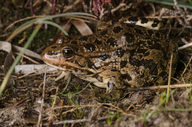|
Pelophylax kurtmuelleri (Gayda, 1940)
Balkan frog, Grenouille des Balkans, Balkanfrosch, Nerobatrachos o balcanicos | family: Ranidae genus: Pelophylax |
 © 2022 David C. Broek (1 of 1) |
|
|
|
Description Gayda (1940) Rana kurtmuelleri bears great resemblance to Rana ridibunda. It was not until 1991 that it was distinguished from the latter by bio-acoustic analysis (Schneider et al 1993). Average body length for males about 72 mm and for females 78 mm. Shape typical of a green waterfrog. Eyes closely set, long hind legs and paired vocal sacs at the corners of the mouth. In most frogs the back is green, but can also be partially or entirely brown. Often there is a light green middorsal longitudinal stripe. Irregular dark green or -in brown animals- dark brown spots are randomly distributed over the back. The tympana are bronze colored or green in the center with a dark periphery. The vocal sacs of the males are light to dark gray (Schneider et al 1993).Distribution and Habitat Country distribution from AmphibiaWeb's database: Albania, Greece. Introduced: Denmark, Italy.
Life History, Abundance, Activity, and Special Behaviors Trends and Threats Comments
References
Gayda, 1940 ''1939'', Atti Soc. Ital. Sci. Nat. Mus. Civ. Stor. Nat. Milano, 79: 267. Gasc, J.-P. (1997). Atlas of Amphibians and Reptiles in Europe. Societas Europaea Herpetologica, Bonn, Germany. Jørgensen, K. 1999. Latterfrøer i Fælledparken! Nord. Herpet. Foren. 42(3): 53-62. Schneider, H., Sinsch, U., and Sofianidou, T. S. (1993). ''The water frogs of Greece.'' Zeitschrift für Zoologische Systematik und Evolutionsforschung, 31, 47-63. Originally submitted by: Arie van der Meijden (first posted 1999-09-27) Edited by: Meredith J. Mahoney, Tate Tunstall, Thomas Uzzell (2008-02-03) Species Account Citation: AmphibiaWeb 2008 Pelophylax kurtmuelleri: Balkan frog <https://amphibiaweb.org/species/4988> University of California, Berkeley, CA, USA. Accessed May 23, 2025.
Feedback or comments about this page.
Citation: AmphibiaWeb. 2025. <https://amphibiaweb.org> University of California, Berkeley, CA, USA. Accessed 23 May 2025. AmphibiaWeb's policy on data use. |


 Map of Life
Map of Life